Breeds of Alpacas - KL
A |
B |
C |
DEFG |
HIJ |
KL |
M |
NOPQ |
R |
S |
TUVWXYZ
|
 Kraienkopp Kraienkopp
|
|
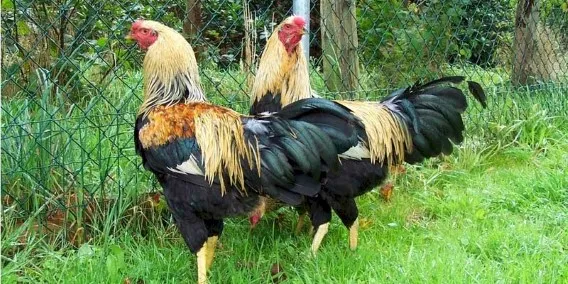 The Kraienkopp, known as Twents Hoen in Dutch, emerges from the misty borderlands between Germany and the Netherlands, a testament to the harmonious blending of cultures and landscapes. Born of meticulous breeding endeavors in the late nineteenth century, these noble fowl bear the genetic imprints of local chickens interwoven with the resilience of Malays and the elegance of Silver Duckwing Leghorns.
The Kraienkopp, known as Twents Hoen in Dutch, emerges from the misty borderlands between Germany and the Netherlands, a testament to the harmonious blending of cultures and landscapes. Born of meticulous breeding endeavors in the late nineteenth century, these noble fowl bear the genetic imprints of local chickens interwoven with the resilience of Malays and the elegance of Silver Duckwing Leghorns.
Their debut on the Dutch stage in 1920 marked the beginning of a storied journey, later captivating the hearts of German enthusiasts in 1925. Despite their illustrious past, Kraienkopps stand today as rare treasures, revered for their dual prowess as both prodigious layers and captivating showbirds. Hens grace the homestead with a ge
...
|
 |
|
 La Fleche La Fleche
|
|
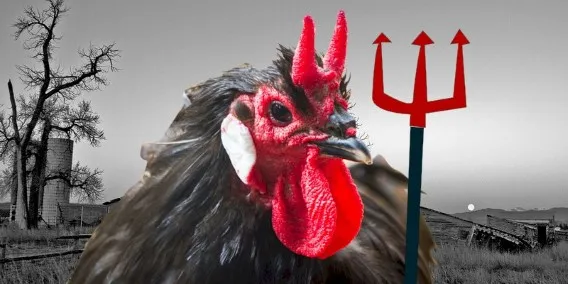 La Fleche
(which is French for the “the Arrow”) chickens have the nickname of “the Devil
Bird” because they have a large red V comb that looks like the classic red
horns associated with the Devil.
La Fleche
(which is French for the “the Arrow”) chickens have the nickname of “the Devil
Bird” because they have a large red V comb that looks like the classic red
horns associated with the Devil.
La Fleche chickens
are a dual purpose bird. They lay three large, extra-large, white eggs a week
from March to October averaging 180 per annum. However, La Fleches stand out as
a meat foul. They seemingly distribute their fat to create an enviable
juiciness in all parts of the carcass. La Fleche chicks grow slowly but make up
for it in flavor and in their high dressed ratio (dressed weight/live weight)
at butchering time.
La Fleche chickens
will adapt to confinement but prefer foraging over roosti
...
|
 |
|
 Lakenvelder Lakenvelder
|
|
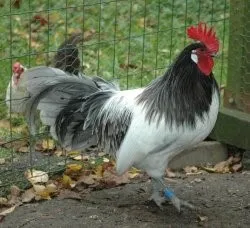 Lakenvelder chickens originate from the Middle East and are
bred primarily for egg production. The hens lay three medium, porcelain white
eggs as week. They are an active breed and they have little time for brooding
and they will seldom sit in a nest. They enjoy foraging and will cover a large
area if allowed to do so. With adequate space they gather most of their own
food. They have delicious, white meat, albeit, minimal in quantity.
Lakenvelder chickens originate from the Middle East and are
bred primarily for egg production. The hens lay three medium, porcelain white
eggs as week. They are an active breed and they have little time for brooding
and they will seldom sit in a nest. They enjoy foraging and will cover a large
area if allowed to do so. With adequate space they gather most of their own
food. They have delicious, white meat, albeit, minimal in quantity.
Lakenvelders adapts well to their environment. Their origins
from the Middle East might lead one to assume that Lakenvelders could only
survive in warmer climates. However, they have thrived in Europe for decades
and adapt to a wide range of weather.
Lakenvelder chickens have man
...
|
 |
|
 Langshan Langshan
|
|
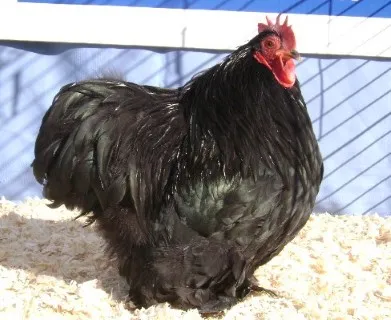 Langshan hens
lay three medium to large brown eggs a week. They lay into the winter months
and usually average 150 eggs per annum. Langshans mature slowly as layers and meat
producers. At twenty four weeks they dress out at seven pounds. They produce a
good quality meat, but their shape lends itself more to a roaster than a fryer.
Langshans can easily clear a six foot fence. They tolerate extremes in
temperature from 100 degrees Fahrenheit to subzero.
Langshan hens
lay three medium to large brown eggs a week. They lay into the winter months
and usually average 150 eggs per annum. Langshans mature slowly as layers and meat
producers. At twenty four weeks they dress out at seven pounds. They produce a
good quality meat, but their shape lends itself more to a roaster than a fryer.
Langshans can easily clear a six foot fence. They tolerate extremes in
temperature from 100 degrees Fahrenheit to subzero.
Langshans
often surprise first-time owners. For a large fowl they prove quite active.
Fortunately, Langshans also possess a docile, calm, and friendly disposition.
They tame easily and live long. Langsshans make a good family pet. The
adaptable Langshan takes to forag
...
|
 |
|
 Legbars Legbars
|
|
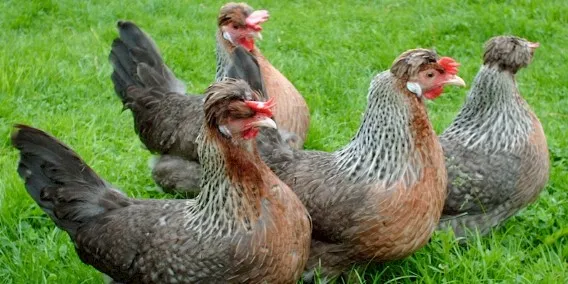 Legbars were
the second autosexing chickens (Autosexing is when day old chicks can be sexed
by their different appearances when they have hatched) that were ever created.
They were developed at Cambridge University in England.
Legbars were
the second autosexing chickens (Autosexing is when day old chicks can be sexed
by their different appearances when they have hatched) that were ever created.
They were developed at Cambridge University in England.
The Gold
Legbar variety was first developed and was developed from a brown Leghorn
rooster and Barred Plymouth Rock Hens, both from utility strains which were
used in the first mating. The second mating took two of the male offspring,
mating them with brown Leghorn hens. After producing many hundreds of chicks,
selection was performed and then these birds were mated and from their
offspring, light colored males with two barring genes were kept together with
the Creem colored females. Silver L
...
|
 |
|
 Lincolnshire Buff Lincolnshire Buff
|
|
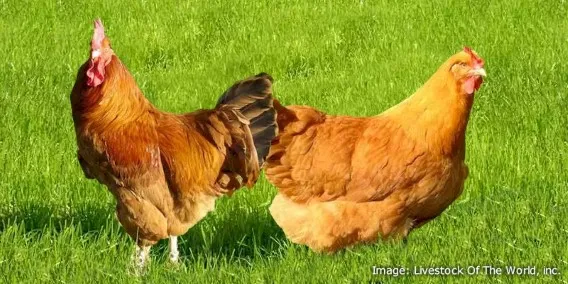 Lincolnshire
Buff chickens were bred in significant numbers on Lincolnshire farms to supply
the London markets between the 1850’s and early 1900’s. The start of this trade
coincides with the development of the railway network that linked the small
market towns with the capital and its opportunities for business. Lincolnshire
Buffs were a fast growing, hardy bird that had excellent table qualities. At
the time, buff was a popular color for table birds since they provided white
table birds that when plucked left a clean carcass without leaving dark feather
stubs.
Lincolnshire
Buff chickens were bred in significant numbers on Lincolnshire farms to supply
the London markets between the 1850’s and early 1900’s. The start of this trade
coincides with the development of the railway network that linked the small
market towns with the capital and its opportunities for business. Lincolnshire
Buffs were a fast growing, hardy bird that had excellent table qualities. At
the time, buff was a popular color for table birds since they provided white
table birds that when plucked left a clean carcass without leaving dark feather
stubs.
During the
1850’s, Dorking chickens were common on most farms and it is thought that Lincolnshire
Buffs were created from crosses between the recently impor
...
|
 |
|
 Livorno Livorno
|
|
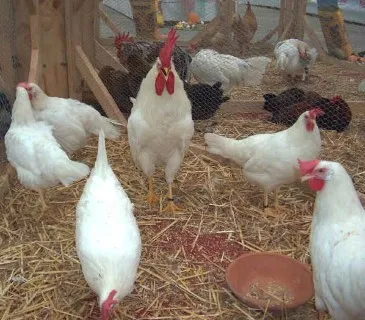 The breed Livorno
or “Italian chicken” is known as “Leghorn” all over the world. The origin is
not so clear, probably from Central Italy, obtained from the selection of light
chicken reared in Tuscany countryside. The name comes from the harbour from
which, in 1828, some flocks have been sent to North America. (In the world
there are many stocks of Leghorn: Italian L., Dutch L., English L., Danish L.,
German Italiener, American L., Canadian L.)
The breed Livorno
or “Italian chicken” is known as “Leghorn” all over the world. The origin is
not so clear, probably from Central Italy, obtained from the selection of light
chicken reared in Tuscany countryside. The name comes from the harbour from
which, in 1828, some flocks have been sent to North America. (In the world
there are many stocks of Leghorn: Italian L., Dutch L., English L., Danish L.,
German Italiener, American L., Canadian L.)
In 1874 was added
to the American Standard of Perfection in its white, black and brown livery.
The white specimen was most of all selected as layer. Later on, the Leghorn
came back to Europe from America, landing at U.K. in 1870 and back to Italy
again. In England they still have
...
|
 |
Top
|